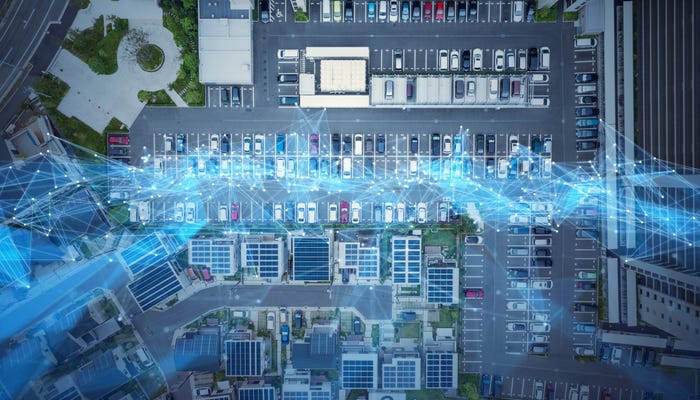Some companies are already using blockchain to securely and centrally understand the flow of goods and services. But it also helps multiple parties share information and operate more efficiently.
June 8, 2020

By H. Paris Burstyn
Key takeaways from this article:
Blockchain enables users to improve quality and customer experience.
In IoT supply chains, blockchain can verify product provenance and track assets creating trusted relationships between suppliers and buyers.
Several well-known companies have implemented blockchain in some of their supply chains.
Blockchain isn’t just for currency anymore. This digital ledger technology is a way of managing transactions and doing business.
Combined with IoT infrastructure, blockchain can support and secure a wide range of supply chain transactions among businesses.
Blockchain is a secure digital ledger that can track data to generate both trusted and immutable exchanges. IoT connects the networks, monitoring devices and applications to track the locations and conditions of products in the supply chain.
[IoT World, North America’s largest IoT event, is going virtual August 11-13 with a three-day virtual experience putting IoT, AI, 5G and edge into action across industry verticals. Register today]
In IoT supply chains, blockchain can verify product provenance and track assets, said Alexandra Rehak, an analyst at Omdia. It creates trusted relationships between suppliers and buyers by generating encrypted, unchangeable records.
Rehak noted that blockchain isn’t used to increase revenue, but to enable users to improve quality and customer experience. Manufacturers of “branded goods,” from routers to luxury items, use it to track component parts to prevent gray market items from slipping into the supply chain. This application assures customers get what they pay for.
Several well-known companies have implemented blockchain in some of their supply chains. Most of these started with individual products, but users expect to deploy it across multiple products.
Tracking the Food Supply
In September 2018, Walmart launched its Food Traceability Initiative after a large outbreak of E. coli in romaine lettuce and Salmonella in various products, from eggs to breakfast cereal, rocked the grocery industry.
It gave its fresh leafy green suppliers a year to enable visibility into produce tracking from store back to the farm. Tracing information includes where the greens were grown, when they were harvested, and the supply chain flow before reaching Walmart’s facilities, stores and clubs. Tejas Bhatt, senior director, Global Food Safety Innovation at Walmart said that a majority of Walmart’s leafy green suppliers now use blockchain technology.
Walmart wants to deliver a seamless and transparent food supply chain to engender customer trust. “We believe we can better protect customers from outbreaks by being more proactive than reactive to issues in the supply chain,” said Bhatt in an email interview. “We want to enhance the customer shopping experience by delivering safe, fresh quality foods whether they shop in store or online with Walmart.”
The Internet of Things (IoT) is a cornerstone of tracking freshness by gathering data on the produce’s shipping environment. To monitor shipping conditions for produce, IoT sensors monitor and control the various devices in the fleets of containers hauling the greens. Walmart is working on tracking temperatures and other factors, where IoT alerts the retailer and its suppliers if conditions stray from the limits that guarantee safety, freshness and quality.
Early results encouraged Walmart to expand the requirement to its green bell pepper suppliers, which have until July 2020 to adopt the blockchain platform. None of the suppliers has requested an extension despite the COVID-19 pandemic, according to Bhatt. Walmart continues to expand the rollout to deliver fresh, high-quality, and safe foods to customers.
Walmart’s blockchain launched as a food safety initiative, said Bhatt. But now the company has expanded its efforts to other parts of the business, including merchandising, sourcing, technology and trade. It also conducted pilots with the U.S. Customs and Border Protection Agency on facilitating faster flow of goods across borders.
Bhatt expects to see incremental benefits as Walmart expands the initiative to other high-risk food items over the next few years. The company aims to get smarter at managing food safety and quality across its supply chains as it compiles more data on blockchain over time
“For Walmart,” Bhatt said, “the [effort] has matured to a point where it’s no longer a ’blockchain’ initiative. Blockchain is just a tool we’re using to deliver transparency. Our goal is to deliver safe, fresh, quality foods to our customers. Blockchain is enabling us to do that.”
KPMG, IBM, Merck, and Walmart Collaboration With FDA
In February 2019, Walmart announced it would collaborate with KPMG, IBM and Merck to work on the Federal Drug Administration’s (FDA) program supporting the U.S. Drug Supply Chain Security Act (DSCSA) that addresses requirements to identify, track and trace prescription medicines and vaccines distributed within the U.S.
The program developed an electronic, interoperable system that identifies and traces certain prescription drugs as they are distributed within the United States. According to Asma Ishak-Mahdi, Walmart’s pharmaceutical blockchain lead, the companies formally kicked off the program in May 2019. Between June and November, the team designed, built and tested the solution.
In May 2019 a Deloitte report described survey results from potential and existing blockchain users around the globe. It noted that, on a tactical level, consortia must consider factors that could be difficult to resolve in a group setting including the following:
Defining goals
Governance/participation structure
Decision making (e.g., equal voting or rotational power)
Who owns the solutions intellectual property
In the Walmart consortium, partners defined the scope to test two Merck vaccine products, which were already dispensed at Walmart to track and trace prescription products and create a shared view of product movement, Ishak-Mahdi wrote in an email. “Merck and Walmart, along with IBM and KPMG, designed, developed and tested the technology, working together as partners.”
Each company contributed its individual experiences and expertise to the trial, Ishak-Mahdi said. IBM provided its blockchain knowledge and its currently in-use global platform (Food Trust). KPMG brought its experience in solving DSCSA’s 2019 requirements with the Healthcare Distribution Alliance (HDA). Merck and Walmart defined business requirements and added operational subject matter expertise related to manufacturer and dispenser roles and responsibilities that were incorporated into the pilot design.
The group built a shared permissioned blockchain network that allows real-time monitoring of products. It reduces the time needed to track and trace inventory; allows timely retrieval of reliable distribution information; increases accuracy of data shared among network members; and helps determine the integrity of products in the distribution chain, including whether products are kept at the correct temperature.
The final report included a decision to add scope and participants and was compiled in December 2019 and January 2020, Ishak-Mahdi said. The consortium submitted it to the FDA in February 2020. It will be posted once the FDA finishes its review of the report.
You May Also Like

.png?width=700&auto=webp&quality=80&disable=upscale)
.png?width=700&auto=webp&quality=80&disable=upscale)
.png?width=300&auto=webp&quality=80&disable=upscale)
.png?width=300&auto=webp&quality=80&disable=upscale)

